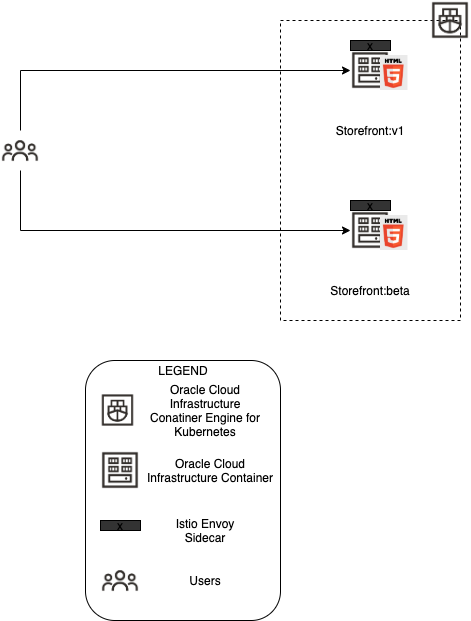Canary Deployment
Introduction
In this section we will demonstrate canary deployment use case with MuShop Application.
One of the benefits of the Istio project is that it provides the control needed to deploy canary services. The idea behind canary deployment (or rollout) is to introduce a new version of a service by first testing it using a small percentage of user traffic, and then if all goes well, increase, possibly gradually in increments, the percentage while simultaneously phasing out the old version. If anything goes wrong along the way, we abort and rollback to the previous version. In its simplest form, the traffic sent to the canary version is a randomly selected percentage of requests, but in more sophisticated schemes it can be based on the region, user, or other properties of the request. Read more details here
We shall demonstrate the simplest canary deployment by using two versions of storefront microservice (storefront:original and storefront:beta) and would split traffic between the two.
- storefront:original would be the original page which does not have the reviews feature.
- storefront:beta would have a new feature called “reviews” displayed on the UI which would let the user’s provide review for their products.
Note: The builds storefront:original and storefront:beta naming conventions are used here for easier understanding. Later during the procedure we will use the exact build version.
Lets look at the diagram which would explain the same

We would configure and run the storefront services in an Istio-enabled environment, with Envoy sidecars injected along side each service. We configure the Istio http routing by creating a VirtualService and Destination rules. Storefront images are available on the Oracle Cloud Infrastructure Registry. We would use them to create a kubernetes deployment.
Pre-Requisites
Deploy Mushop
Download and install Istio Service Mesh
Deploy storefront beta
-
Create a deployment with the below config and name it mushop-storefrontv2.
Note: We will use the same labels as that of storefront original.
cat << EOF | kubectl apply -f -
apiVersion: apps/v1
kind: Deployment
metadata:
labels:
app.kubernetes.io/instance: mushop
app.kubernetes.io/name: storefront
name: mushop-storefrontv2
namespace: mushop
spec:
replicas: 1
selector:
matchLabels:
app: storefront
app.kubernetes.io/instance: mushop
app.kubernetes.io/name: storefront
template:
metadata:
labels:
app: storefront
app.kubernetes.io/instance: mushop
app.kubernetes.io/name: storefront
version: 2.1.3-beta.1
spec:
containers:
- image: iad.ocir.io/oracle/ateam/mushop-storefront:2.1.3-beta.1
imagePullPolicy: Always
name: storefront
EOF
"apiVersion: apps/v1
kind: Deployment
metadata:
labels:
app.kubernetes.io/instance: mushop
app.kubernetes.io/name: storefront
name: mushop-storefrontv2
namespace: mushop
spec:
replicas: 1
selector:
matchLabels:
app: storefront
app.kubernetes.io/instance: mushop
app.kubernetes.io/name: storefront
template:
metadata:
labels:
app: storefront
app.kubernetes.io/instance: mushop
app.kubernetes.io/name: storefront
version: 2.1.3-beta.1
spec:
containers:
- image: iad.ocir.io/oracle/ateam/mushop-storefront:2.1.3-beta.1
imagePullPolicy: Always
name: storefront" | kubectl apply -f -
Create Istio resources
-
Deploy a Gateway resource
cat << EOF | kubectl apply -f - apiVersion: networking.istio.io/v1alpha3 kind: Gateway metadata: name: gateway namespace: mushop spec: selector: istio: ingressgateway servers: - port: number: 80 name: http protocol: HTTP hosts: - '*' EOF"apiVersion: networking.istio.io/v1alpha3 kind: Gateway metadata: name: gateway namespace: mushop spec: selector: istio: ingressgateway servers: - port: number: 80 name: http protocol: HTTP hosts: - '*'" | kubectl apply -f - -
Deploy a VirtualService and DestinationRules
cat <<EOF | kubectl apply -f - apiVersion: networking.istio.io/v1alpha3 kind: VirtualService metadata: name: edge namespace: mushop spec: hosts: - '*' gateways: - gateway http: - match: - uri: prefix: /api route: - destination: host: mushop-api.mushop.svc.cluster.local - match: - uri: prefix: /assets rewrite: uri: / route: - destination: host: mushop-assets.mushop.svc.cluster.local - route: - destination: host: mushop-storefront.mushop.svc.cluster.local subset: original weight: 50 - destination: host: mushop-storefront.mushop.svc.cluster.local subset: beta weight: 50 EOF"apiVersion: networking.istio.io/v1alpha3 kind: VirtualService metadata: name: edge namespace: mushop spec: hosts: - '*' gateways: - gateway http: - match: - uri: prefix: /api route: - destination: host: mushop-api.mushop.svc.cluster.local - match: - uri: prefix: /assets rewrite: uri: / route: - destination: host: mushop-assets.mushop.svc.cluster.local - route: - destination: host: mushop-storefront.mushop.svc.cluster.local subset: original weight: 50 - destination: host: mushop-storefront.mushop.svc.cluster.local subset: beta weight: 50 | kubectl apply -f -- Destination Rule
cat <<EOF | k apply -f - apiVersion: networking.istio.io/v1alpha3 kind: DestinationRule metadata: name: reviews-destination spec: host: mushop-storefront.mushop.svc.cluster.local subsets: - name: original labels: version: 2.1.2 - name: beta labels: version: 2.1.3-beta.1 EOF"apiVersion: networking.istio.io/v1alpha3 kind: DestinationRule metadata: name: reviews-destination spec: host: mushop-storefront.mushop.svc.cluster.local subsets: - name: original labels: version: 2.1.2 - name: beta labels: version: 2.1.3-beta.1" | kubectl apply -f - -
Open a browser with the EXTERNAL-IP of the Istio ingress gateway
kubectl get svc istio-ingressgateway \ --namespace istio-systemLocating
EXTERNAL-IPfor Istio Ingress Gateway. NOTE this will be localhost on local clusters.
Testing
Open a Incognito/Private window of a browser and access http://EXTERNAL-IP/.
Try to refreshing the URL multiple times and you would see two different storefront UI’s (original and beta) with 50% of traffic going to each.
Noticing the issues
- Review page ratings star icon wont fill when clicked.
Roll Back
-
We would change the routing back to default as below
cat <<EOF | kubectl apply -f - apiVersion: networking.istio.io/v1alpha3 kind: VirtualService metadata: name: edge namespace: mushop spec: hosts: - '*' gateways: - gateway http: - match: - uri: prefix: /api route: - destination: host: mushop-api.mushop.svc.cluster.local - match: - uri: prefix: /assets rewrite: uri: / route: - destination: host: mushop-assets.mushop.svc.cluster.local - route: - destination: host: mushop-storefront.mushop.svc.cluster.local port: number: 80 EOF"apiVersion: networking.istio.io/v1alpha3 kind: VirtualService metadata: name: edge namespace: mushop spec: hosts: - '*' gateways: - gateway http: - match: - uri: prefix: /api route: - destination: host: mushop-api.mushop.svc.cluster.local - match: - uri: prefix: /assets rewrite: uri: / route: - destination: host: mushop-assets.mushop.svc.cluster.local - route: - destination: host: mushop-storefront.mushop.svc.cluster.local port: number: 80" | kubectl apply -f -
Cleanup
Uninstall Istio by passing the generated manifests into kubectl delete
istioctl manifest generate --set profile=demo | kubectl delete -f -
Mushop Cleanup refer